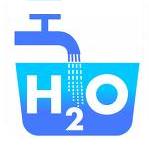

PROPERTIES OF WATER
Characteristic Properties of Water
Pure water is virtually a non-conductor of electricity. On heating to a very high temperature water molecules are dissociated into the elements. The formation of water front hydrogen’ and oxygen is an exothermic reaction:
H2+ ½O2 =3 H20 (Steam) ΔH = 58,110 calories.
Pure water takes part in a variety of chemical reactions. Pure water at room temperature acts on alkaline metals violently and on alkaline earth metals rapidly with evolution of hydrogen. Magnesium and aluminum amalgams are rapidly attacked. Magnesium, iron, zinc and carbon react with water at high temperature. Iron and lead are also attacked by water in the presence of air.
Hard water has less reaction on lead than pure and soft water, as the sulphates and bicarbonates present in hard water form a coating of sulphates and carbonates of lead upon the metal which protect it from further action. Hence, soft water should not be supplied for drinking purposes through lead pipes. A solution containing traces of lead is poisonous to the human system. Water acts as a catalyst for many physical and chemical changes. Perfectly dry hydrogen and oxygen do not react. Although pure water is a non-conductor, water shows a slight dissociation.
2H2O = (H30)+ + (OH)-
At 25° C, the ionic product of water is is l X lO-i4. Water is. an excellent electrolytic solvent, particularly for ionic com-pounds.
Hard and soft water
Water is differentiated by hard water Or soft water, as per the combination reaction with soap solution.
Water that easily forms a lather of films and froths when -agitated with a soap solution is known as soft water.
Water that reacts with soap solution to form a white scum only without producing a lather easily, is said to be hard water. Hard water does not, therefore, yield a lather easily until a considerable amount of soap has been used Up.
The hardness of water is due to the presence of dissolved salts of metals (except the salts of alkali metals such as sodium or potassium), notably those of calcium, magnesium and iron, in water.
Besides the presence of bicarbonates of calcium and magnesium (which cause carbonate or temporary hardness ) and sulphates and chlorides of calcium and magnesium (which cause permanent hardness ) water may also contain varying amounts of sodium salts, silica, iron, alumina and manganese. Other impurities present in water may be the suspended impurities which cause turbidity, organic matter dissolved gases and coloring matter. The dissolved gases may be carbon dioxide, oxygen, nitrogen and hydrogen sulphide (in sulfurous waters).
As a matter of interest the constituents of sea water will give an idea of the chemical elements present. The major elements present, besides oxygen and nitrogen, are chlorine, sodium, magnesium, sulfur, calcium, potassium; minor elements present are bromine, carbon, strontium, boron and the trace elements are iodine, copper, lithium, silver and gold.
The difficulties involved in removing all these impurities are obvious. While calcium, magnesium and iron are removed by water-conditioning, silica is removed with difficulty by ferric coagulation. Presence of soluble sodium salts do not harm boiler-feed water. Alumina and manganese are seldom removed; if required, manganese is removed by aeration followed by filtration or filtration through manganese-zeolites.
From sea water, potassium and bromine are removed as potassium bromide, sodium and iodine as sodium bromide; sulfur, carbon and chlorine separate as sulphates, carbonates and chlorides of calcium, manganese and iron respectively. Boron, lithium and copper are difficult to separate these are allowed to remain as such in industry. Picking of gold particles from river water in basins is an age-old process.
The best form of pure water is of course distilled Water Treatment. Distillation Water Treatment Process keeps back all types of impurities.
Leave a Reply







 LIKE TO GET UPDATES
LIKE TO GET UPDATES  TO GET EXPERT GUIDE
TO GET EXPERT GUIDE